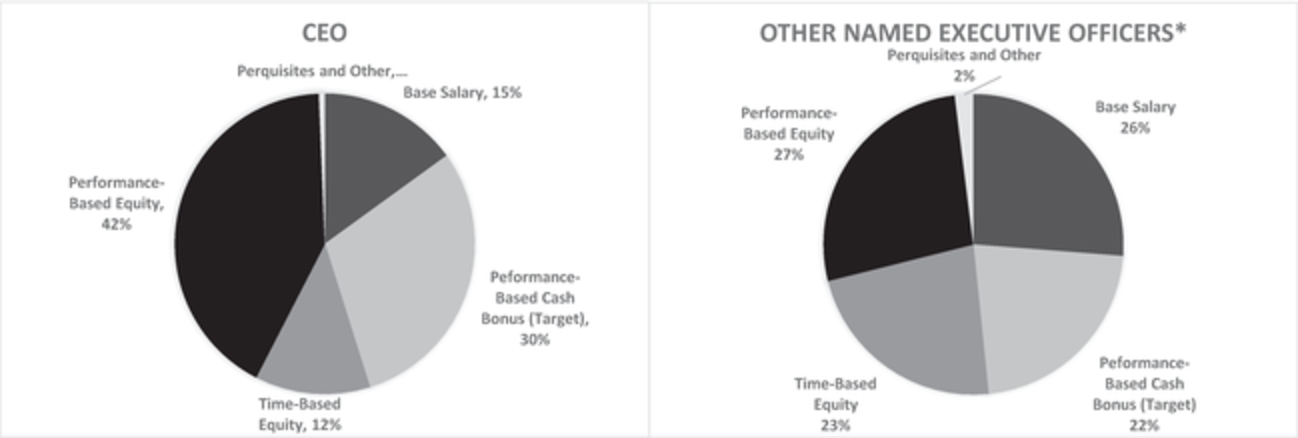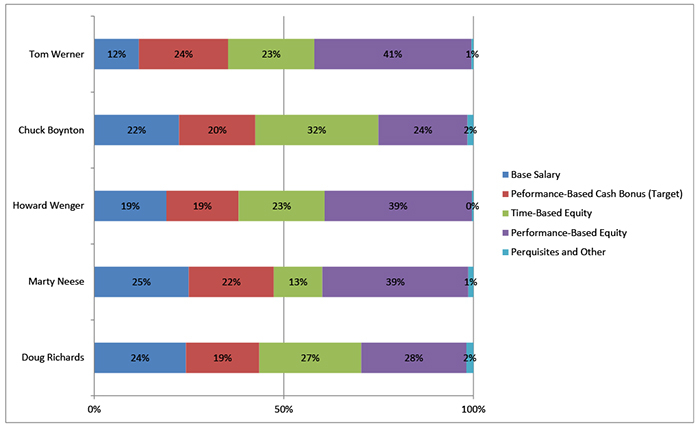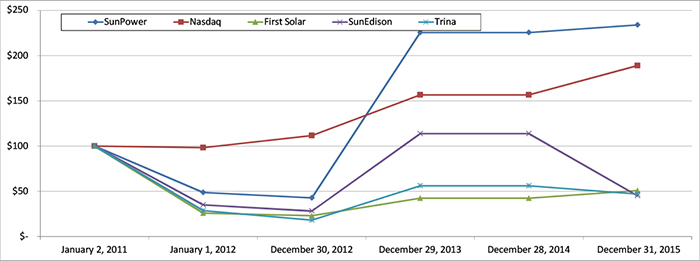EXECUTIVE OFFICERS
CertainBiographical information as of March 17, 2016, regarding each offor our executive officers, other than Mr. Werner, is set forthlisted below. Biographical information for Mr. Werner, who is both a director and an executive officer of the Company, can be found in the section entitled “Proposal One—Re-Election of Class II Directors.”
Name | Age | | | | | Position |
NameKenneth Mahaffey | 50 | | Age | | Position | Executive Vice President and General Counsel |
Thomas H. WernerWilliam Mulligan III | 58 | 56 | | Former Executive Vice President, Chief Executive Officer and Chairman of the BoardGlobal Operations |
Charles D. BoyntonDouglas Richards | 60 | 48Executive Vice President, Administration |
Manavendra Sial | 42 | Executive Vice President and Chief Financial Officer |
Howard J. Wenger | | 56 | | President, Business Units |
Marty T. Neese | | 53 | | Chief Operating Officer |
Lisa Bodensteiner | | 54 | | |
Kenneth Mahaffey is the Executive Vice President, General Counsel, and Corporate Secretary
Douglas J. Richards | | 57 | | Executive Vice President, Administration |
Eric Branderiz | | 51 | | Senior Vice President, Corporate Controller and Chief Accounting Officer |
Mr. Thomas H. Werner has served as our President and Chief ExecutiveEthics and Compliance Officer since May 2010,of SunPower with responsibility for the Company’s global legal organization. He is an accomplished executive with more than 20 years of legal experience. Mr. Mahaffey joined SunPower in 2006 as a founding member of our Board since June 2003,legal department. During his tenure, Mr. Mahaffey has managed attorneys and Chairmanprofessionals around the globe who handle all legal, contract, regulatory, and compliance matters in support of the Board of Directors since May 2011. From June 2003 to April 2010,Company’s core business segments. He has also provided lead support for the Company’s corporate functions, including finance, mergers and acquisitions, marketing, policy, and communication. Mr. Werner served as our Chief Executive Officer.Mahaffey has deep expertise in renewable energy law, finance, corporate governance, and compliance matters. Before joining SunPower, he worked as an attorney in private practice managing a variety of commercial and litigation matters. Mr. Mahaffey has a Bachelor of Arts degree from 2001 to 2003, he held the positionUniversity of Chief Executive OfficerCalifornia, San Diego, and a Juris Doctor degree from McGeorge School of Silicon Light Machines, Inc., an optical solutions subsidiary of Cypress Semiconductor Corporation. From 1998 to 2001, Mr. Werner was Vice President and General ManagerLaw, University of the Business Connectivity Group of 3Com Corp., a network solutions company. He has also held a number of executive management positions at Oak Industries, Inc. and General Electric Co., and currently serves as a board member of Cree, Inc., Silver Spring Networks, and the Silicon Valley Leadership Group. Mr. Werner is on the Board of Trustees of Marquette University. Mr. Werner holds a bachelor’s degree in industrial engineering from the University of Wisconsin–Madison, a bachelor’s degree in electrical engineering from Marquette University, and a master’s degree in business administration from George Washington University.Pacific.
Mr. Charles D. Boynton hasWilliam Mulligan III served as our Executive Vice President, and Chief Financial Officer since March 2012. In March 2012, Mr. Boynton also served as our Acting Financial Officer. From June 2010Global Operations, from February 2017 to March 2012, he served2019, and was responsible for leading our global operations and worldwide materials sourcing. Dr. Mulligan originally joined SunPower in 1998 and worked for more than 12 years as our Vice President Financeof research and Corporate Development,development, where he drove strategic investments, joint ventures, mergersled the development of our photovoltaic cell technology and acquisitions, field finance and finance, planning and analysis. Before joiningthe world’s highest efficiency commercial solar panel. He left SunPower in June 2010, Mr. Boyntonbut returned four years later with our acquisition of SolarBridge, where he was the Chief Financial Officer for ServiceSource, LLC from April 2008 to June 2010. From March 2004 to April 2008 he servedserving as the Chief Financial Officer at Intelliden. Earlier in his career, Mr. Boynton held key financial positions at Commerce One, Inc., Kraft Foods, Inc. and Grant Thornton, LLP. He is a member of the board of trustees of the San Jose Technology Museum of Innovation and has served as ChairmanPresident and Chief Executive Officer of 8Point3 Energy Partners LP since June 2015. Mr. BoyntonOfficer. Most recently, he was a certified public accountant, State of Illinois, and a Member FEI, Silicon Valley Chapter. Mr. Boynton earned his master’s degree in business administration at Northwestern University and his Bachelor of Science degree in business from Indiana University.
Mr. Howard J. Wenger has served as our President, Business Units since October 2014. From November 2011 to October 2014, Mr. Wenger served as President, Regions. From January 2010 to October 2011, Mr. Wenger served as President, Utilities and Power Plants. From August 2008 to January 2010, Mr. Wenger served as President, Global Business Units, and led all of our business units since January 2007 as an executive officer of the Company. From 2003 to 2007, Mr. Wenger served as ExecutiveSunPower’s Vice President, and a member ofUpstream Strategy. He also served on the board of directors of PowerLight Corporation, a solar system integration company that we acquiredDongfang Huansheng Photovoltaic (Jiangsu) Co., Ltd., our manufacturing joint venture in January 2007 and subsequently renamed SunPower Corporation, Systems with Mr. Wenger serving as President. From 2000 to 2003, Mr. Wenger was Vice President, North American Business of AstroPower Inc., a solar power manufacturer and system provider acquired by General Electric, and from 1998 to 2000 he was the Director, Grid-Connected Business. From 1993 to 1998, Mr. Wenger co-founded and managed Pacific Energy Group, a solar power consulting firm and, from 1989 to 1993, Mr. Wenger worked for the Pacific Gas & Electric Company, a utility company in northern California, in both research and strategic planningChina. Dr. Mulligan has more than 30 years of solar and distributed generation assets. Mr. Wenger holds a Bachelor of Arts degreemicroelectronics industry experience, and prior to SunPower served in environmental studiesvarious engineering and management positions at JX Crystals, Inc., the National Renewable Energy Laboratory, AstroPower, and Fairchild/National Semiconductor. Dr. Mulligan received dual undergraduate degrees in chemistry and history from the University of California, Santa Barbara, andWashington, a Mastermaster’s of Science degreescience in chemical engineering from the University of Colorado, Boulder.
Mr. Marty T. Neese has served as our Chief Operating Officer since June 2008. From October 2007 to June 2008, Mr. Neese served as Executive Vice President, Worldwide Operations of Flextronics International Ltd., a manufacturing services company. From September 2004 to October 2007, Mr. Neese servedMichigan, and his doctorate in a variety of senior management positions at Solectron Corporation, a manufacturing services company, most recently as its Executive Vice President, Worldwide Operations. Mr. Neese also served in the U.S. Army for five years, reaching the rank of Captain. He is a graduate of the United States Military Academy at West Point. He received his master’s degree in business administrationmaterials science from the UniversityColorado School of Florida.
Ms. Lisa BodensteinerMines. He holds 10 patents and has served as our Executive Vice President, General Counsel and Corporate Secretary since June 2012. From October 2009 to June 2012, Ms. Bodensteiner served in roles with increasing responsibility, and most recently as General Counsel, Project Development at First Solar Inc. From October 2007 to April 2009, Ms. Bodensteiner served as Vice President and General Counsel at OptiSolar Inc., a privately held, vertically integrated solar energy producer, manufacturer of proprietary thin-film photovoltaic solar panels and developer of utility-scale solar farms. Before OptiSolar, Ms. Bodensteiner hadauthored more than a decade of experience at Calpine Corporation, serving in various legal roles including as Executive Vice President, General Counsel, Secretary and Chief Compliance Officer. From 198930 publications related to 1996, Ms. Bodensteiner practiced as a transactional attorney at law firms. Ms. Bodensteiner earned a Bachelor of Science degree in business administration from the University of Nevada, Reno, and a J.D. from Santa Clara University.solar energy.
Mr. Douglas J. Richards has served as our Executive Vice President, Administration, since November 2011. From April 2010 to October 2011, Mr. Richards served as our Executive Vice President, Human Resources and Corporate Services. From September 2007 to March 2010, Mr. Richards served as our Vice President, Human Resources and Corporate Services. From 2006 to 2007, Mr. Richards was Vice President of Human Resources and Administration for SelectBuild, a construction services company and a wholly-ownedwholly owned subsidiary of BMHC, and from 2000 to 2006, Mr. Richards was Senior Vice President of Human Resources and Administration for BlueArc, a provider of high performance unified network storage systems to enterprise markets. Before BlueArc, Mr. Richards spent 10 years at Compaq Computer Corporation and five years at Apple Computer, Inc. in various management positions. Mr. Richards graduated from California State University, Chico, with a Bachelor of Arts degree in public administration.
Mr. Eric BranderizManavendra Sial has served as our Senior Vice President, Corporate Controller and Chief Accounting Officer since August 2012, was Vice President, Corporate Controller and Chief Accounting Officer from September 2011 to July 2012 and wasExecutive Vice President and Corporate Controller from June 2010 to August 2011. Concurrent with his other responsibilities, as of March 2016, Mr. Branderiz is also Senior Vice President, Head of Corporate Tax,Chief Financial Officer since May 2018, leading the Company’s treasury, project finance, investor relations, financial planning, and accounting organizations. Previously, he served as Senior Vice President, Headthe chief financial officer for VECTRA, a $1 billion technology-driven diversified industry business, which was a portfolio company of Corporate Financial Planning & Analysiscertain funds managed by affiliates of Apollo Global Management, LLC. Prior to VECTRA, Mr. Sial was with SunEdison in various global finance and operations leadership roles from June2011 to 2015, to March 2016including chief financial officer of MEMC’s solar energy and as Senior Vice President, Global RLC Operations and Financematerials divisions. He also spent 11 years with General Electric (GE) in a variety of roles, from March 2013 to September 2014. Mr. Branderiz was the Vice President, Corporate Controller, Treasurer, and Head of Subsidy Business OperationsFP&A leader for the Knowledge Universe (KU)Energy Services unit to Chief Financial Officer of Power Delivery for GE’s Transmission and Distribution group. He earned his master’s degree in business administration from May 2009 to May 2010. Before KU, he servedDuke University’s Fuqua School of Business and his Bachelor of Commerce from Delhi University in various positions at Spansion, Inc. from June 2003 to April 2009, including as the Corporate Vice President, Corporate Finance & Corporate Controller. Before Spansion’s initial public offering, Mr. Branderiz served in several concurrent capacities as Corporate Controller, Head of Corporate Financial Planning & Analysis, Head of Regional Sales & Marketing Finance, and Internal Controls. Before Spansion, Mr. Branderiz held various positions at Advanced Micro Devices, Inc., including Americas Regional Controller; he also held positions at Ernst & Young, LLP, and the Provincial Branch of Consumer & Corporate Affairs, Alberta Securities Commission and Treasury Departments in Canada. He is a California licensed Certified Public Accountant and earned a Business Commerce degree from the University of Alberta, Canada.India.












